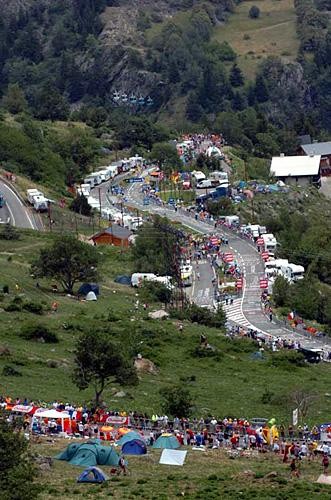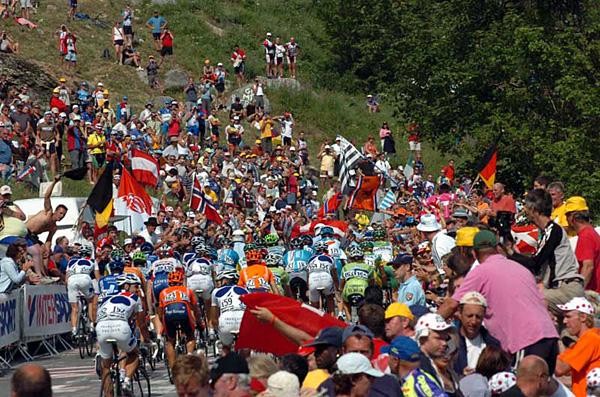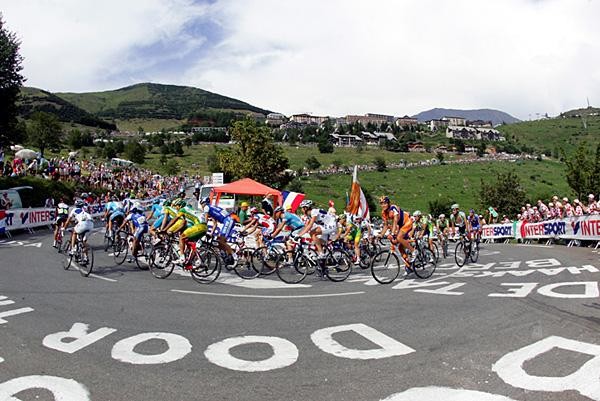Giantkiller and legend maker: L’Alpe D’Huez and its history
Tour de France News feature, July 18, 2006 Climbed just 24 times in the history of the Tour de...



Tour de France News feature, July 18, 2006
Climbed just 24 times in the history of the Tour de France, l’Alpe d’Huez is nevertheless the legendary climb, with only Mont Ventoux rivalling its reputation. Cyclingnews’ Shane Stokes takes a look at some of the facts and figures associated with the mountain.
Today’s fifteenth stage of the Tour de France is notable for a couple of reasons. It’s the first in the Alps, it’s the first real test for yellow jersey Oscar Pereiro and the next big opportunity for Floyd Landis and all the overall challengers. But most of all, it is notable as the race is heading to l’Alpe d’Huez, probably the most famous climb in cycling.
The mountain was first used back in the 1952 Tour de France and the dominant stage win achieved there by Fausto Coppi set a precedent which is almost always the case. Whoever wears the yellow jersey after the stage to the 1860 metre summit is, historically, almost guaranteed to win the Tour. This has been done 19 times, with the rule being broken on just five occasions. Exceptions include Laurent Fignon’s maillot jaune in 1989 and François Simon’s spell in yellow in 2001; however, if a superstitious rider is in yellow tonight, he’ll be feeling reassured with those stats.
Coppi dominated in 1952 but the crushing nature of his win – and the suspense-killing effect it had on the race – meant that it was a full 24 years before the race returned. Joop Zoetemelk topped the podium in 1976 and started a dominant period by riders from the Netherlands, with eight out of the thirteen finishes there between that year and Gert-Jan Theunisse’s 1989 victory falling to competitors from that country.
This in turn led to it’s unofficial christening as the ‘Dutch Mountain’ and the regularly huge influx of beer drinking orange-clad spectators. More recently the top prize has gone in other directions, though, with six Italian wins, three American victories and one Spanish triumph.
Strangely enough, given its reputation, l’Alpe d’Huez is itself is not regarded as the toughest climb in cycling. The bare statistics explain why: it is just 13.8 kilometres in length at an average gradient of 7.9%. However the big difficulty is that it tends to come at the end of a very hard day in the mountains, with the riders in this year’s Tour tackling the hors categorie Col d'Izoard (14.5 km climb at 7 %) and the category two Col du Lautaret (12.1 km climb at 4.4%) beforehand. The level of fatigue will be high by the time they race around the first of 21 hairpin bends and this, plus the effect of the preceding climbs, will explain the big time gaps at the finish.
Get The Leadout Newsletter
The latest race content, interviews, features, reviews and expert buying guides, direct to your inbox!
Speaking of times, an analysis of those recorded makes for interesting reading. There is some variation in the records due to the fact that it was 1994 before official timekeeping began, and also because the reference point has changed in the years since.
From 1994 to 1997 the climb was timed from a point 14.5km from the finish. The introduction of a photo finish system in 1999 meant that a point 14 km from the line was used, but in the interests of comparisons the times mentioned below have all been taken from the same location; 13.8 kilometres from the finish, at the corner which marks the start of the climb.
Unofficially, the top twelve times are as follows :
1 Marco Pantani (1995) 36’50
2 Marco Pantani (1997) 36’55
3 Marco Pantani (1994) 37’15
4 Lance Armstrong (2004) 37’36
5 Jan Ullrich (1997) 37’40
6 Lance Armstrong (2001) 38’05
7 Miguel Indurain (1995) 38’10
8 Alex Zülle (1995) 38’10
9 Bjarne Riis (1995) 38’15
10 Richard Virenque (1997) 38’20
11 Iban Mayo (2003) 39’06
12 Giuseppe Guerini (1999) 41’52
From these statistics a number of things are clear. Firstly, the late Marco Pantani may have never won the maillot en pois but he is the real King of the Mountain, recording the three fastest times in history. Interestingly, each of these were faster than Lance Armstrong’s time trial ride in 2004, which was itself 29 seconds faster than his The Look performance in 2001. Jan Ullrich’s 37’40 recorded en route to his 1997 Tour victory splits Armstrong’s two marks, while Miguel Indurain and Alex Zülle’s identical time in 1995 puts them seventh and eighth. Bjarne Riis was five seconds back in the same year, while Virenque’s pursuit of Pantani and Ullrich in 1997 puts him tenth with 38’20.
Iban Mayo’s 39’06 and Giuseppe Guerini’s 41’52 in 2003 and 1999 are listed as eleventh and twelfth, although our own feeling on this is that Jan Ullrich’s runner up performance in the 2004 l’Alpe d’Huez time trial must surely have been faster than both of these. On that day he was just 1’01 slower than Lance Armstrong, although a flat approach means that this is not necessarily the actual difference between the two on the climb.
Interestingly, eight of the top ten times were recorded between 1994 and 1997.
As stated, there is a lack of clear records available but it is reported that Bernard Hinault and Greg LeMond climbed the mountain in a considerable 48 minutes back in 1986. It was a very different era then.
As regards what will happen today, the stage should give the clearest indication thus far as to who can win this Tour de France. The list of contenders has been thinning down, but there are still several riders in the shakeup for the final victory. The tough slopes of l’Alpe d’Huez should further clarify things as to who is going well and should figure in the two remaining days in the mountains.
We previously stated that being in yellow tonight is a desirable thing if you are superstitious. Historically, a strong showing on l’Alpe d’Huez has proved crucial to Tour success. However, somewhat paradoxically, while taking (or holding) yellow here bodes well for the final overall classification, winning the stage does not. Only Coppi and Armstrong have succeeded in taking victory both here and in Paris. Something the GC contenders might keep in mind, perhaps.
Past winners
1952 - Fausto Coppi
1976 - Joop Zoetemelk
1977 - Hennie Kuiper
1978 - Hennie Kuiper
1979 - Joop Zoetemelk*
1979 - Joaquim Agostinho*
1981 - Peter Winnen
1982 - Beat Breu
1983 - Peter Winnen
1984 - Luis Herrera
1986 - Bernard Hinault
1987 - Frederico Echave
1988 - Steven Rooks
1989 - Gert-Jan Theunisse
1990 - Gianni Bugno
1991 - Gianni Bugno
1992 - Andy Hampsten
1994 - Roberto Conti
1995 - Marco Pantani
1997 - Marco Pantani
1999 - Guiseppe Guerini
2001 - Lance Armstrong
2003 – Iban Mayo
2004 – Lance Armstrong
* The climb was scaled twice in 1979.